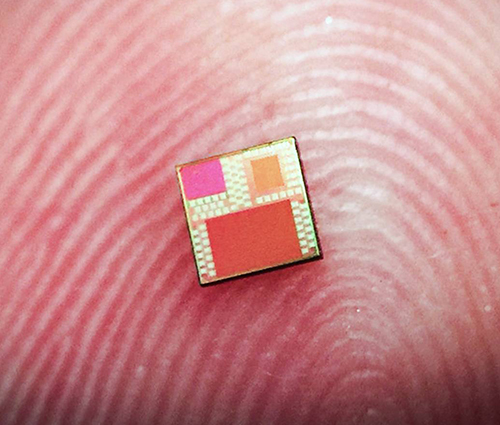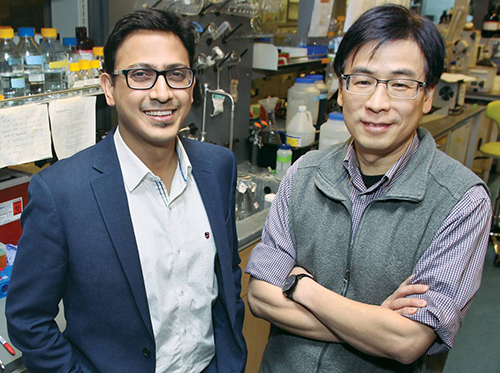Miniaturization of clinical laboratory testing continues to intrigue pathology researchers, medical scientists, and diagnostics developers who see the technology as a way to bring pathology diagnostics to resource deficient areas
Can useful, fast, and cheap medical laboratory tests be performed using the million-pixel cameras found in today’s smartphones, in combination with microchips and other technologies? A team of researchers at Princeton University believe they are on the path to achieving those goals.
Dark Daily has covered the development of “lab-on-a-chip” miniature diagnostic technologies for many years. Through these diminutive devices, clinical laboratory testing has been brought to remote regions of the world where even basic resources like electricity and adequate clean water are in short supply.
The Princeton researchers are developing their own tiny biosensor microchip. The device reads fluorescent light and could, they say, be used to diagnose disease from inside the human body.
The researchers published their findings in ACS Photonics, a journal of the American Chemical Society (ACS), and Biomedical Optics Express, an online journal published by The Optical Society. Both peer-reviewed scientific journals specialize in the fields of photonics and optics.
Revolutionary Use of Standard Microchip Technology
The device developed by the Princeton University researchers uses silicon chip technology to perform various types of clinical laboratory assays.
“The key idea is to allow complex optical systems in modern-day chips,” said Kaushik Sengupta, PhD, Assistant Professor of Electrical Engineering at Princeton and one of the project leaders, in a press release. “All smartphones carry a million-pixel camera. How do we turn this into a device that allows laboratory-quality diagnostics?”

The researchers discovered that existing microchip technology can be adapted to “take advantage of light’s unusual behavior when interacting with structures smaller than wavelength of light,” the press release noted.
“We show these complex optical biosensor systems can also be realized in the same technology with absolutely no change in manufacturing the microchip,” Sengupta said.
Employing existing manufacturing would make mass producing the chips highly cost effective compared to other lab-on-a-chip technologies. And, if the diagnostics are accurate as well, clinical laboratories could have a remarkable new tool to aid physicians in the diagnosis of disease.
How It Works
The Princeton scientists say light harnessed by the fluorescence-based biosensor can detect and differentiate biological substances ranging from bacterial Deoxyribonucleic acid (DNA) to hormones present in humans.
They also claim their sensor can detect tiny molecules, such as DNA and proteins, in liquid samples as small as one microliter. By comparison, a single drop of water holds about 50 microliters. The researchers say the sensitivity of their microchip in analyzing this tiny sample is comparable to results achieve by diagnostic laboratories.

Like a traditional lab setup, the chip uses chemical antibodies to target certain molecules. These antibodies are then altered to propagate a specific light wavelength when they are exposed to a distinct molecule. Exposure to ultraviolet light causes the antibodies to glow a faint red color when they come into contact with the targeted substance.
Cheaper Diagnostics for the Developing World
The researchers hope that their miniature chip will someday be used as a mainstream diagnostic technology, and that it may lead to the development of other, similar diagnostic products.
“Once we make the diagnostics cheaper, we can enable diagnostics in the developing world,” stated Sengupta. “And it’s not just diagnostics. What we have come up with here is just a low-cost, tiny fluorescent sensor and you can use fluorescent sensing in many different things: for food and water-quality monitoring, environmental monitoring, and industrial applications.”
More research is required to ensure the effectiveness of the new technology. And it will need to receive clearance from the federal Food and Drug Administration (FDA) before going into widespread production. Nevertheless, this newest miniature lab-on-a-chip technology could prove beneficial to clinical laboratories in the future, as a cost-effective tool to diagnose disease and better serve medical professionals and patients in resource-strapped regions of the world.
—JP Schlingman
Related Information:
New Technology Marks Key Step Toward Shrinking a Medical Lab to Fit on Fingertip
IBM and Mount Sinai Researchers Develop Innovative Medical Lab-on-a-Chip Solution
Lab-on-a-Chip Diagnostics: When Will Clinical Laboratories See the Revolution?



